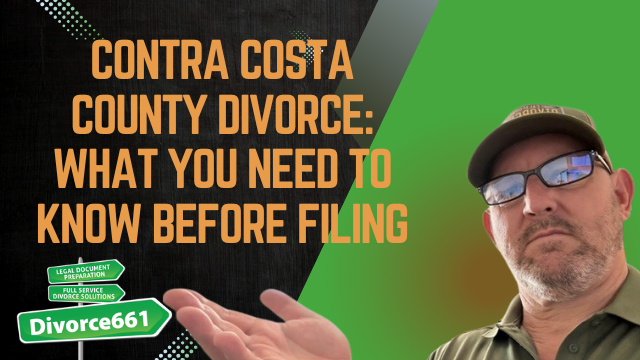San Bernardino Divorce Checklist: Everything You Need
Hi, I’m Tim Blankenship from Divorce661. If you’re preparing to file for divorce in San Bernardino County, this straightforward 5-step checklist will help you avoid common delays and court rejections. I’ll walk you through each step, explain the required forms, and share practical tips so your case moves as smoothly and quickly as possible.
Why follow a checklist?
Filing for divorce involves specific forms, strict filing and service procedures, and mandatory financial disclosures. Missing a single step can cause the court to reject your paperwork or delay the process. Follow these five steps to reduce stress and get your case processed efficiently.
Quick overview: The 5-step checklist
- File the petition, summons, and UCCJEA (if you have children)
- Properly serve your spouse and file proof of service
- Exchange required financial disclosures
- Prepare and sign a marital settlement agreement (MSA)
- Submit the full judgment package for court approval
Step 1 — File your paperwork
Start by filing the Petition for Dissolution and the Summons with the San Bernardino County court. If you have minor children, include the UCCJEA (Uniform Child Custody Jurisdiction and Enforcement Act) form so the court has the necessary custody jurisdiction information.
At Divorce661, we eFile these documents directly with the court to ensure they’re accepted and entered into the case correctly.
Step 2 — Serve your spouse correctly
Service is critical. If your spouse is cooperative, you can often serve by mail. If service by mail isn’t an option, you must use personal service (a third party personally hands the documents to your spouse). After service, you must file a Proof of Service with the court to show your spouse was properly notified.
- Cooperative spouse: service by mail may be acceptable
- Uncooperative or unknown whereabouts: personal service is required
- Always file the Proof of Service to avoid rejection
Step 3 — Exchange financial disclosures
California requires both parties to exchange detailed financial information. The two core documents are:
- Schedule of Assets and Debts
- Income and Expense Declaration
These disclosures give the court and each spouse a clear picture of assets, debts, income, and monthly expenses—information that’s essential for dividing property and determining support. Completing and exchanging these forms promptly keeps your case moving forward.
Step 4 — Sign a Marital Settlement Agreement
If you and your spouse can reach an agreement, the next step is to put that agreement in writing. A Marital Settlement Agreement (MSA) covers:
- Division of property and debts
- Spousal support (if applicable)
- Child custody and visitation, and child support (if applicable)
Having a comprehensive MSA makes it far more likely the court will approve your judgment quickly. Make sure the MSA addresses all issues you want resolved so the court can enter a complete judgment.
Step 5 — Submit the full judgment package
Once the petition, service proof, disclosures, and signed MSA are ready, submit the full judgment package to the court. If the packet is complete, the court can approve and enter your judgment in just a few weeks—even before the mandatory six-month waiting period ends for the final judgment date.
That’s real: we helped a San Bernardino couple who followed this exact checklist and had their divorce paperwork approved in 30 days. Their part was signing the agreement and letting the court process the completed package.
“We’ll make the process fast, smooth, and stress-free.”
How Divorce661 helps
At Divorce661 we handle every part of this checklist so you don’t miss a step. Our services include:
- Flat-fee divorce services—no hidden costs
- eFiling your documents with the San Bernardino court
- Managing service and filing the Proof of Service
- Preparing and exchanging mandatory financial disclosures
- Drafting the Marital Settlement Agreement and submitting the full judgment package
We aim to do it right the first time so you can avoid court rejections and unnecessary delays.
Common questions
How long does a divorce take in San Bernardino?
California has a mandatory six-month waiting period from the date the served spouse files their response or from the date of default. However, if your judgment packet is complete and unopposed, the court can approve the paperwork well before that six-month mark. Proper paperwork and timely disclosures are what make that possible.
Do I need an attorney?
Not always. Many amicable couples resolve matters through an agreement and file the judgment package themselves. That said, having experienced help to prepare forms, ensure proper service, and draft a solid MSA greatly reduces risk. If you want assistance, Divorce661 offers flat-fee support and handles the entire process for amicable cases.
Next steps
If you’re ready to start your San Bernardino divorce with confidence, schedule a free consultation at Divorce661. We’ll review your situation, explain the exact paperwork you need, and outline how to follow the checklist so your case proceeds without surprises. Visit Divorce661.com to book your free phone consultation.
Final thoughts
Divorce doesn’t have to be chaotic. Follow this 5-step San Bernardino divorce checklist, complete your disclosures, and put your agreement in writing. With careful preparation—and the right help—you can make the process fast, smooth, and stress-free.










